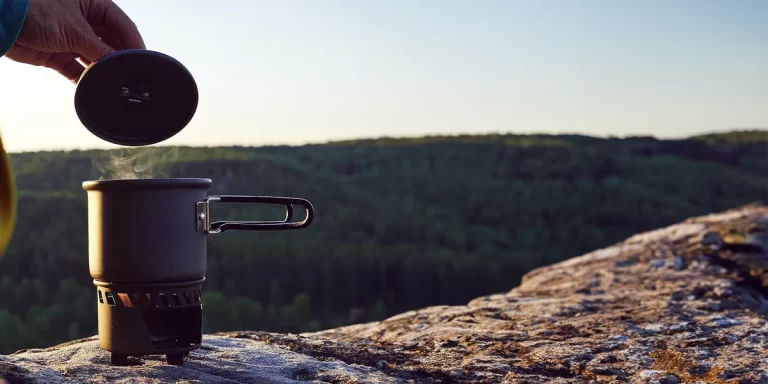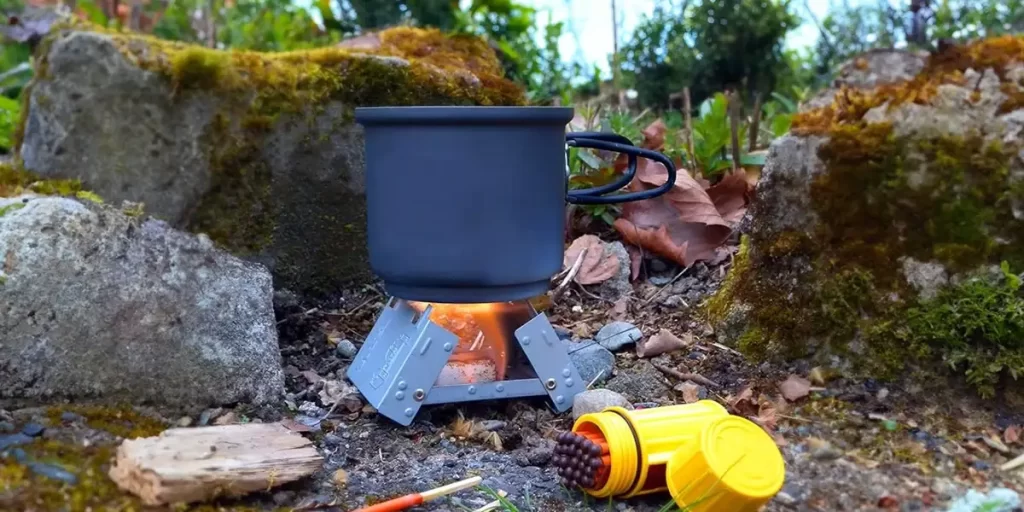

Want the lightest camping stove? Then solid fuel backpacking stoves may be perfect for your next adventure. These small stoves are ideal for anyone wanting to carry less weight.
In this post, we’ll talk about what solid fuel stoves are and how they work. We’ll also discuss why they’re so convenient for camping, hiking, and emergencies.
Most importantly, we’ll look at how they compare to other stove options. And we’ll give you tips on choosing the right one.
Interested? Let’s dive in!

Solid fuel stoves are simple but incredibly useful tools for outdoor cooking. Let’s break down the basics:
What Are They?
Solid fuel stoves are small gadgets made to burn fuel tablets or other materials, creating heat for cooking during camping. Although their designs differ, they usually have a basic setup with a plate for the fuel and a stand for your pot.
While multi-fuel stoves capable of burning both alcohol and solid fuels are available, we always prefer the dedicated option – a purpose-built solid fuel stove in this case.
How Do They Work?
You place a solid fuel tablet (often made of hexamine1 or trioxane2) inside the stove, ignite it, and it starts burning steadily. The heat from the burning tablet is what you use to cook your food or boil water. However, for optimal efficiency, you’d need to bring a windscreen.
How Light Are They?
The lightest solid fuel stoves weigh approximately one-tenth of an ounce. Fuel like ESBIT tablets also weigh half an ounce. Just one tablet can boil 2 cups of water. So for a 3-day trip, your full cook setup could weigh less than 2 oz. That’s as light as many canister stoves, without the extra weight of the canister.
Popular ultralight solid fuel backpacking stove options include:
| Make / Model | Weight oz (g) |
|---|---|
| Trail Designs Gram Cracker (survival use) | 0.1 (3g) |
| ESBIT Solid Fuel Stove Titanium | 0.39 (11) |
| Gram-counter Gear Titanium Tablet Stove | 0.49 (14) |
Like everything else, solid fuel stoves have their strengths and weaknesses. Let’s take a closer look at what makes them a great choice and where they might fall short:
Pros:
| Portability: Solid fuel stoves are very compact and light, never weighing you down on trips. |
| Ease of Use: Lighting fuel tablets is easy, so these stoves are user-friendly even for beginners. |
| Low Maintenance: Unlike gas stoves, solid fuel stoves need little to no upkeep. |
| Eco-Friendly: Fuels like hexamine and trioxane burn very clean, leaving minimal residue. |
Cons:
| Slower Cooking: Heating generally takes longer vs. liquid/gas stoves. |
| Higher Fuel Costs: Tablets are pricier than other fuel options. |
| Availability: Finding tablets could be tougher than other fuels depending on location. |
| Temperature Control: Flame control isn’t as precise as some more advanced stoves. |
| Wind Performance: Setting up wind protection is needed to help maximize efficiency. |
| Potential Odors: Some fuels may produce undesirable combustion odors. |

So let’s get to the meat and potatoes – how should you choose your solid fuel backpacking stove? Here are some key factors to consider before putting one in your backpack:
The right solid fuel stove will boil water quickly while remaining lightweight and low-maintenance for the trail. Focus on efficiency, stability, and packability for backcountry adventures.
Still not sure if solid fuel stoves are for you? Well, they offer unique advantages, but how do they stack up against other stove types commonly used by outdoor enthusiasts?
Let’s compare them to liquid fuel and gas burner stoves:
| Comparison Criteria | Solid Fuel Stoves | Liquid Fuel Stoves | Gas Stoves |
|---|---|---|---|
| Portability | Very portable and lightweight | Less portable due to fuel bottle | Portable and lightweight |
| Ease of Use | Simple to operate, easy to light | More involved priming and pumping | Easy ignition, good temperature control |
| Fuel Availability | Fuel tablets less common | Liquid fuel more widely available | Gas canisters widely available |
| Environmental Impact | Low emissions, clean burn | Higher emissions from liquid fuel | Low emissions, clean burn |
| Cost | Inexpensive stoves, affordable fuel | More expensive stoves, fuel costs vary | More expensive stoves initially, fuel costs vary |
| Cold Weather Performance | Struggle in freezing temperatures | Operate well in cold conditions | Moderate cold weather ability |
| Simmering Ability | Low ability to simmer | Good simmering control | Excellent simmering ability |
Thus, we can conclude that solid fuel stoves excel in terms of simplicity and portability, making them great for minimalistic camping and ultralight enthusiasts.
However, if you prioritize precise temperature control or anticipate cooking in cold conditions, you might lean toward liquid fuel or gas stoves.
Solid fuel stoves are ideal for ultralight backpackers, offering compactness, simplicity, and reliable performance in outdoor cooking.
While they excel in user-friendliness and low maintenance, they may not quite match the rapid heating and precise temperature control of liquid fuel or gas stoves. Nevertheless, we highly recommend giving them a try.
In the end, your decision should be guided by your unique requirements and preferences. Here’s to happy experimenting and unforgettable wilderness adventures.
Looking for an ultralight backpacking stove? Explore our TOP 5 guide to discover the lightest options on the market.
You cannot bring solid fuel tablets on a plane. These items are considered hazardous materials due to their flammable nature, and airlines typically prohibit them in both carry-on and checked luggage. It’s essential to follow airline regulations and TSA guidelines to ensure a safe and hassle-free journey. If you need solid fuel for outdoor activities at your destination, it’s often best to purchase them locally or make suitable arrangements once you arrive.
Test results show an efficient bacpacking stove can boil 1 liter of water using around 2-3 esbit tablets, which weighs about 1-1.5 ounces. This compares well to integrated canister stove systems that require 2-3 ounces of fuel to boil the same amount of water.
Many wilderness areas impose fire bans during dry conditions to prevent wildfires, but how do bans affect backpacking stoves? Canister stoves and liquid fuel stoves are generally allowed since they have an enclosed flame. Solid fuel stoves, however, are often restricted. Wood burning is usually prohibited for backcountry use during fire bans. Stoves that burn wood pellets, pine cones, or other unprocessed natural materials are also typically banned. Esbit or hexamine tablet stoves are a gray area – some areas allow them, while others prohibit their use.
Using water to clean a solid fuel backpacking stove is not recommended, as the soot and residue left behind is not water-soluble. Instead, it’s best to let the stove completely cool after use, then brush away any leftover ash or soot with a dry cloth. Gently scraping with a spatula can help remove stubborn buildup. Allow all remaining residue to dry completely before storing. Only use cleaning products approved for solid fuel stoves if extra scrubbing is needed. Following the manufacturer’s instructions for your particular stove model is wise.